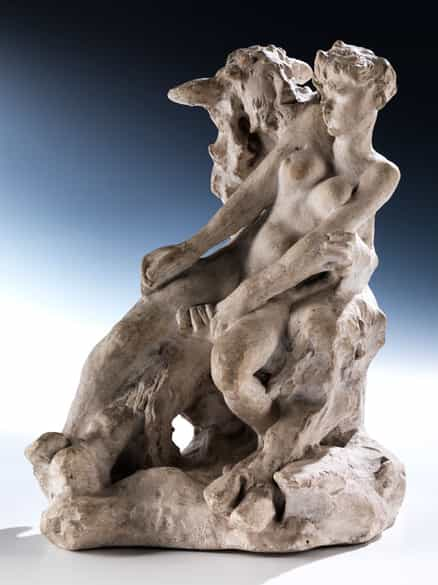Auction Modern Art
» reset
Your personal art agent

You would like to purchase a similar object?
We are happy to inform you, if similar works are to be auctioned in one of our upcoming auctions.
Please accept our privacy policy
999
Auguste Rodin,
1840 - 1917
FAUN UND NYMPHEHöhe: 33,5 cm.
Catalogue price € 110.000 - 120.000
Catalogue price€ 110.000 - 120.000
$ 118,800 - 129,600
£ 99,000 - 108,000
元 860,200 - 938,400
₽ 10,943,900 - 11,938,800
Dem Objekt ist eine Expertise von Gilles Perrault vom 1.12.2014 beigegeben.
Das Werk ist auch unter dem Titel „Faun oder Minotaurus und Nymphe“ bekannt, da der stürmisch nach der nackten Nymphe Greifende mit übergroßen Hufen wiedergegeben ist, die eher an Stier- denn an Geißhufe erinnern. Rodin hat zu dieser Unstimmigkeit gemeint, es wäre ihm nicht auf die Wiedergabe mythologischer Fakten angekommen, sondern allein auf den Ausdruck von Körperform und Bewegung. Die Nymphe ist auf einem Felsensockel sitzend dargestellt und versucht sich der Umarmung des Fauns zu entziehen. Die Großartigkeit der bildhauerischen Leistung ist allein schon in der Tatsache zu sehen, dass es Rodin wie kaum einem anderen Künstler seiner Zeit gelang, die natürliche Bewegung trotz naturalistischer Auffassung der Körpers in eine stilistisch durchdachte Komposition zu binden, wie dies in der großen Diagonale von links unten nach rechts oben zu erkennen ist. Auch die schon genannten übergroßen Tierfüße des Fauns oder aber seine großen Rinderohren sind als stilistische Überhöhungen trotz der naturalistischen Wiedergabe zu werten. Während Kopf und Gesicht des Mädchens, wie ihre Körperhaltung überhaupt, ganz dem Geschehen verpflichtet sind, hat Rodin das Gesicht des Fauns weitgehend stilisiert. Das ursprüngliche Modell zu der vorliegenden Plastik entstand um 1885. Im Steinsockel ist noch die geritzte Aufschrift als Widmung an seinen Freund ("A mon ami Michelet") zu erkennen sowie die Signatur, hier allerdings durch den Abguss etwas abgemildert. Das Original wurde um Anfang 1919 mehrfach in Gips sowie in Bronze ausgeformt. Die Nachgüsse erfolgten nach dem Tode des Künstlers in sehr geringen Auflagen. Eine Ausführung in Marmor befindet sich im Folkwang Museum in Essen, 1904 für das Folkwang Museum Hagen erworben, seit 1922 in Essen. Weitere Exemplare, wie hier ebenfalls in Gips, befinden sich im Los Angeles County Museum of Art sowie in Paris im Musée Marmottan. Eine weitere Ausführung in Bronzeguss befindet sich ebenfalls im County Museum in Los Angeles. Erstmals wurde das Bildwerk 1889 von Gustave Geffroy beschrieben in seinem Vorwort des Katalogs der Ausstellung „Monet-Rodin“, dort ebenfalls als "Satyr und Nymphe" oder "Nymphe und Faun" betitelt. Gips mit Alterspatina. Am Felsensockel rechts noch erkennbar die Widmungsaufschrift und Signatur.
Literatur:
Antoinette Le Normand-Romain, Rodin et les Bronzes, Catalogue des oeuvres conservées au musée Rodin, Bd. 2, Paris, 2007, Beschreibung S. 524.
Pierre Michel und Jean Francois Nivelet, Octave Mirbeau. Correspondance avec Auguste Rodin, Tousson, 1988, Beschreibung S. 242. (1000751) (11)
Auguste Rodin,
1840 – 1917
FAUN AND NYMPH
Height: 33.5 cm.
Accompanied by an expert's report by Gilles Perrault dated 1st January 2014.
This artwork is also known under the title “Faun or Minotaur and Nymph” as the faun, who is passionately reaching for the nymph is depicted with oversized hooves, rather reminiscent of bull’s than of goat’s hooves. Rodin replied to this discrepancy that he wasn’t interested in rendering mythological facts but only in the abstract expression of body shape and movement. The magnificence of the sculptural achievement can be seen in the fact that Rodin, like hardly any other artist of his time, achieved to tie the natural movement, despite a naturalistic body concept, into a stylistically sophisticated composition. Whilst the head and face of the girl (as the rest of her posture in general) are entirely engaged in the event, Rodin largely stylized the Faun’s face. The original design for the present sculpture dates back to circa 1885. An incised inscription with dedication to his friend can still be made out on the stone base (“A mon ami Michelet”) as well as the signature, which is however slightly softened by the cast. The original was shaped numerous times in plaster as well as bronze around the beginning of 1919. The recasts were executed after the artist’s death in very small editions. The sculpture was first described by Gustave Geffroy in his preface to the exhibition catalogue “Monet-Rodin” in 1889, where it is also titled as “Satyr and Nymph” or “Nymph and Faun”.
Literature:
Antoinette Le Normand-Romain, Rodin et les Bronzes, Catalogues des oeuvres conservées au musée Rodin, vol. II, Paris, 2007, described on p. 524.
Pierre Michel and Jean Francois Nivelet, Octave Mirbeaux. Correspondance avec Auguste Rodin, Tousson, 1988, described on p. 242.
This object has been individually compared to the information in the Art Loss Register data bank and is not registered there as stolen or missing.
Your personal art agent
You would like to be informed of upcoming auctions if a similar work of art is offered? Activate your personal art agent here.
Please accept our privacy policy
You would like to purchase a similar object?
Your personal art agent Purchase in Private Sale Calendar
Our experts are happy to support you personally in your search for art objects.
You would like to sell a similar artwork in auction?
Consign now Private Sale Service FAQ
Your consignments are always welcome.
Our staff will be happy to personally assist you every step of the way. We look forward to your call.
Get in touch with our experts
further catalogues Furniture & Interior | Sculpture and Works of Art | 19th - 20th Century Paintings | Silver, Porcelain, Glass, Caskets & decorative Objects | Art nouveau until the 1960s | Russian Art, Boxes and Miniatures | Asian Art, non-european Art, antiquities | The Saxon Treasure | 16th - 18th Century Paintings | Luxury auction | Modern Art | Hampel Living






















